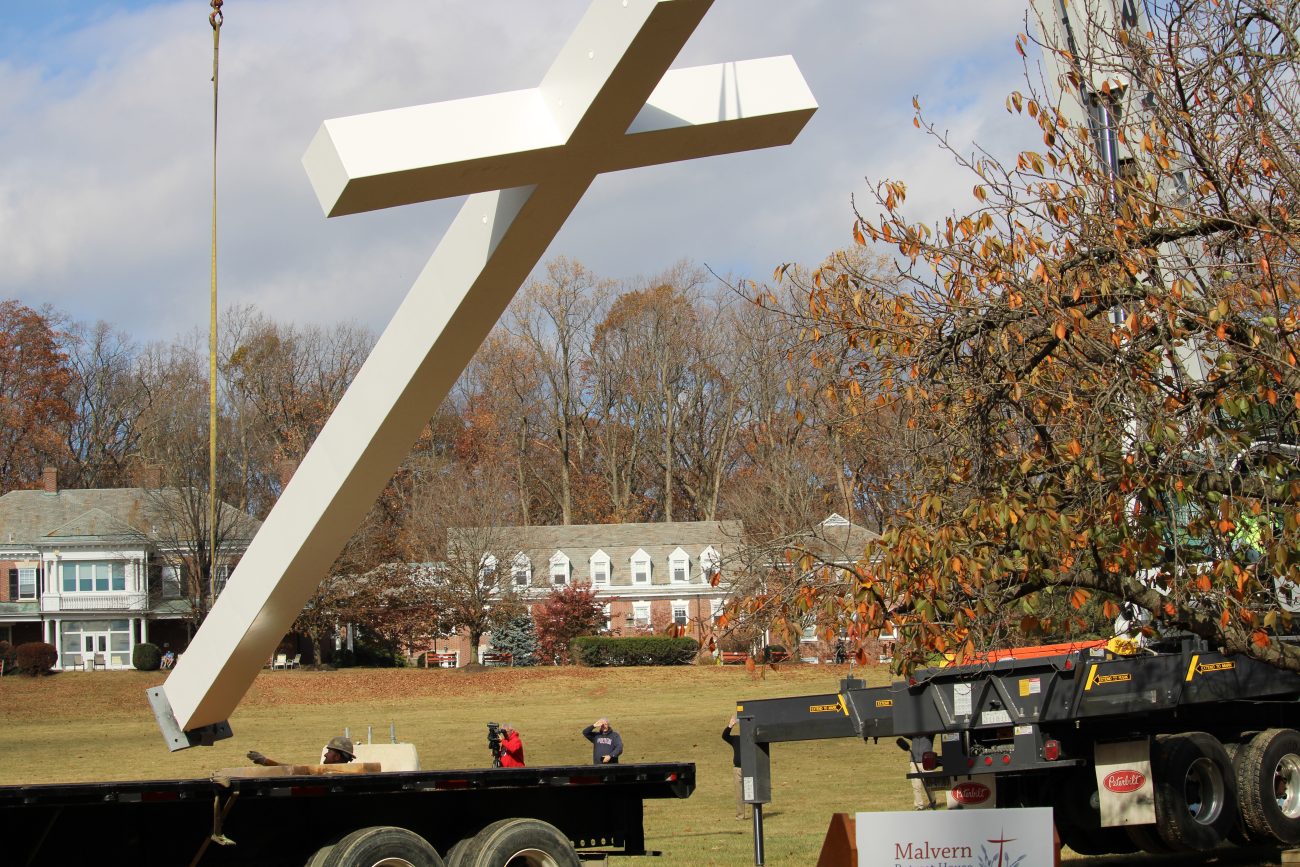More than a million people descended upon Logan Circle on a beautiful autumn day in Center City Philadelphia Oct. 3, 1979, for a Mass celebrated by Pope John Paul II, the polish cardinal who had been elected pontiff less than a year earlier.
At the center of it all, above a covered fountain on the city’s Logan Circle, the pope celebrated Mass on an expansive altar in the shadow of an enormous 34-foot white cross.
In the days after the papal visit, the cross — a symbol of one of the largest Catholic gatherings in North America at that time — was taken to the outskirts of the city where it was erected on the grounds of St. Charles Borromeo Seminary. It has been on display at the busy intersection of Lancaster and City Avenues the last 45 years.
Earlier this year, St. Charles Seminary moved to its new campus in Lower Gwynedd as the seminary’s Overbrook campus was sold.
Fast forward to Monday, Nov. 11, another beautiful weather day in the Philadelphia area, and the refurbished cross was unveiled at its new place of honor at Malvern Retreat House where Father Douglas McKay, rector, offered prayers for a gathering of about 100 people.
The formal rededication of the cross is scheduled for June at a Mass to be celebrated by Archbishop Nelson Pérez.
Father McKay, a seminarian in 1979, had been chosen to be cross bearer at the Mass with the pontiff.
“It means to me … what this is all about … the cross is the most precious image that we have, because it’s a symbol of the paschal mystery of Jesus,” Father McKay said. “The life, the death and the resurrection of Jesus. It’s so eucharistic. And the Holy Father, John Paul II, he was so eucharistic. He was so contemplative.”
Father McKay recalls the pope praying before the huge gathering.
“Then we started the procession to the holy sacrifice of the Mass. That’s what this cross is all about, the holy sacrifice of the Mass, the gateway to God, where all the glory lies. What it means to me is eucharistic, the holy sacrifice of the Mass, and the banquet of heaven that is now. The kingdom of God is with us now.”
Of course, it’s the type of ceremony a person never forgets.
“The privilege of being the cross bearer, Oct. 3, 1979,” he said, “standing next to the Holy Father as he celebrated the Mass … that’s what it all means to me. It’s all about the paschal mystery. Life, death and resurrection, coming home to God where we all belong.”
The idea of bringing the cross to Malvern came when a priest friend and seminary official called Father McKay. With the Overbrook campus closing and officials unsure of what to do with the cross, the priest asked, “Do you think Malvern would want it?”
“Everybody got excited,” the rector said.
The blessing and installation included remarks from Michael Norton, president of Malvern Retreat House. Father McKay said Norton and the active Malvern volunteers and donors were instrumental in helping arrange the heavy lifting required for the move.
The steel cross was moved to the grounds of the retreat house where a team of craftsmen painstakingly restored it for permanent installation on the 125-acre campus.
Officials said many individuals and companies have donated their time to the initiative, including JPC Group, Inc., Pennoni Engineering and Thackery Crane Rentals. JPC Group is a family-owned, full-service construction contractor operated by the Petrongolo family, whose members have been coming to Malvern for decades, organizers said.
Malvern Retreat House is billed as the oldest and largest Catholic retreat community in the nation. Founded more than 100 years ago as the Layman’s Retreat League, Malvern hosts retreats for men, women, couples and young Catholics. It includes three chapels, four private oratories, four Stations of the Cross walks, a replica of the Grotto at Lourdes and countless shrines.
In August, Malvern was recognized as having the official diocesan shrine to Blessed Carlo Acutis, the first millennial saint to be canonized likely in 2025 by the Catholic Church.
And now it has a very large relic connected to St. Pope John Paul II.
***
Joseph P. Owens is editor of The Dialog, newspaper of the Diocese of Wilmington, where this story first appeared. It is used by permission.
PREVIOUS: Priests, Lay Writers Pen Weekly Commentaries on Sunday Gospels
NEXT: For 50 Years, Mass on 6ABC Brings Worship of God to Homebound




Share this story